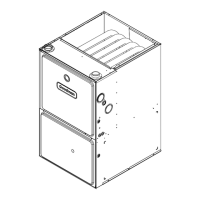
Do you have a question about the Goodman GME95 and is the answer not in the manual?
Procedures for documenting and filing claims for damage discovered upon delivery.
Identifies components in the upflow/horizontal furnace configuration via diagram.
Identifies components in the counterflow/horizontal furnace configuration via diagram.
Crucial warnings about installation, operation, and maintenance to prevent injury or death.
Specific warnings for enclosed areas to prevent CO poisoning risks.
Details residential, commercial uses, and construction site heater limitations.
Procedures to prevent damage to electronic components from static electricity.
Centrally locating the furnace, return air temp, and avoiding combustible materials.
Lists substances that contaminate combustion air and cause performance issues.
Instructions for suspending the furnace using threaded rod and angle iron.
Procedures and considerations when removing an old furnace from a venting system.
Recommended placement and factors to avoid for accurate temperature sensing.
Details on providing adequate air for combustion and ventilation in various spaces.
Diagrams and explanations for supplying outside air via ducts or direct openings.
Guidance on furnace orientation, ductwork attachment, and side panel considerations.
Ensuring proper leveling and provisions for alternate vent/flue piping in horizontal installs.
Details on required kits and orifice/pressure switch adjustments for propane and high altitude.
Specifies clearances for direct vent terminals based on Canadian and US codes.
Specifies clearances for non-direct vent terminals based on codes.
Warnings and guidelines for using PVC pipe and ensuring proper flue system integrity.
Adherence to instructions for safe and proper furnace performance related to piping.
Restrictions and requirements for vent and combustion air intake termination points.
Instructions for connecting vent/flue and combustion air intake pipes to the furnace.
Options for connecting vent/flue and combustion air piping through side panels.
Table for applicable pipe lengths, elbows, and diameters for non-direct vent systems.
Details on vertical and horizontal vent/flue pipe termination methods and clearances.
Instructions for running vent/flue and combustion air pipes for direct vent systems.
Explains the need for condensate drainage and precautions for freezing temperatures.
Refers to directions for concentric vent kit installation specifications.
Step-by-step instructions for connecting drain hoses for upright installations.
Specific connection details for upright installations using alternate vent/flue outlets.
Special instructions for left-side trap installation in upright configurations.
Instructions for connecting drain hoses and trap for horizontal installs with right side down.
Instructions for connecting drain hoses and trap for horizontal installs with left side down.
Procedures for securing the drain trap to the side panel in horizontal installations.
Steps to move the junction box to an alternate side panel for wiring access.
Guidelines for making 115V power supply connections, including grounding and circuit protection.
Instructions for low voltage wiring of the thermostat to the integrated control module.
How to connect optional accessories like an electronic air cleaner to the furnace.
Warnings and guidance on converting to propane and handling high altitude installations.
Specifies inlet gas supply pressure ranges and altitude derating considerations.
Details on connecting the furnace to the building's gas piping, including unions and drip legs.
Guidelines for sizing propane gas tanks and piping based on capacity and length.
Importance of proper ductwork design and filter installation for furnace performance.
Procedure for measuring total external static pressure to ensure proper airflow.
Importance of filters and guidelines for their selection and installation.
Step-by-step instructions for initiating furnace operation and safety checks.
Procedures for normal furnace operation, including startup and shutdown steps.
Procedure for measuring and verifying inlet gas supply pressure using a manometer.
Steps for measuring and adjusting gas manifold pressure for burners.
Method for measuring natural gas input rate using the gas meter.
How to measure and adjust temperature rise by modifying circulator blower speed.
Guidance on selecting and adjusting blower speeds for heating and cooling.
Steps taken when power is first applied to the furnace.
Describes the operational sequence for heating, including single and two-stage modes.
Outlines the operational sequence when the furnace is in cooling mode.
Describes the sequence when only the circulator blower is activated.
Explanation of the electronic control module's role in safety and diagnostics.
Descriptions of primary, auxiliary, rollout limits, and pressure switches.
Explains how to use the diagnostic LED and chart for fault codes.
Key areas to inspect annually for proper furnace operation and safety.
Procedure for cleaning heat exchanger flue passageways and related components.
Steps to take before leaving the installation site, including homeowner orientation.
Information on how to order necessary parts, including required details.
Identifies common operational issues and their corresponding LED codes and solutions.
Addresses problems related to circulator blower operation and flame sensing.
Tables detailing CFM and temperature rise for various models and external static pressures.
Performance data tables for AMEH96 models, showing CFM and temperature rise.
Electrical schematic for MH95 models, showing component connections and color codes.
Electrical schematic for ACSH96/GCH95/GCH9 models, illustrating wiring configurations.
Electrical schematic for GME95/AMEH96 models, detailing component wiring.
Specific mandates for CO detector installation and signage for vented appliances.

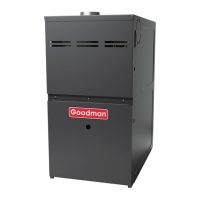
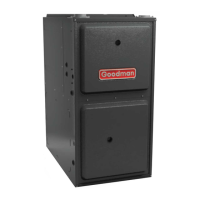
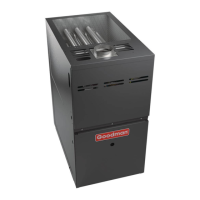
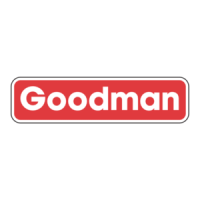







